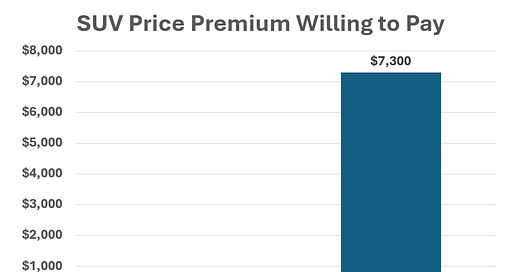(Thanks to Kent Hendricks for digging this one up!)
We all know that what car you drive says something about you. If you really like Grand Funk Railroad, you may still have a Screaming Chicken Firebird in the back of your garage. If you’re a Dog Person, the DMV will go ahead and automatically issue you a Subaru. And then there is the dating and mating scene. If I lease that ‘Vette, will the ladies give me a second look?
Well, Car Charts is about nothing if it is not about bringing data-based reason to the massively irrational world of cars.1 Thus we turn to research from back in 2013, as to whether or not one’s perception of her or his gender, err, “security” affects one’s car purchases.
WARNING: Any discussion of gender nowadays is about as safe as a daylight sprint across an open field in the Donbas. There is no opinion I could issue here that would not cause outrage among any number of readers. So please take this post as what it is intended to be: a light-hearted and informal poke at an oft-discussed topic. Frankly, I doubt the four researchers whose work is cited here would even consider such research in 2025, lest they all be canceled. But I guess 2013 was a less tense time, or more innocent, or maybe just less enlightened!2
The researchers in question were interested in “The masculine overcompensation thesis, [ which ] asserts that men react to masculine insecurity by enacting extreme demonstrations of their masculinity.” Okay, but why this is here is because cars enter into the “demonstrations.”
They assembled about 100 volunteers (who were paid for their time) and gave them the Bem Sex Role Inventory test, which asks respondents to indicate how well a series of adjectives (e.g. soft-spoken, competitive) describes their personality. The results are scored on a 50-point scale, with 0 to 25 as the masculine side of neutral, and 26 to 50 as the feminine side. (Thus a score of 0 would indicate hyper-masculinity, and 50 hyper-femininity.) Regardless of how they actually scored, half of the men were told they had scored an 11, which is solidly masculine, and half were told they had scored a 32, inside the feminine range. Similarly, half of the women were told they had scored 39 (solidly feminine), and half 18, inside the masculine range. Once their (fake) scores were revealed, all the participants were asked to fill out two questionnaires, with their test results still fresh in their minds. One questionnaire asked about their attitudes towards broad social and political issues, such as homosexuality and the Bush-era wars in the Middle East. Then the researchers looked at how these responses differed between those given the different scores.
But of interest to this blog was the second questionnaire, about vehicle preferences. Participants were given detailed descriptions of four different Ford automobiles (an SUV, a minivan, a sedan, and a coupe3), and asked to rate how desirable each vehicle was (on a 10-point scale), and how much they would be willing to pay for each one.
For purposes of this research, the researchers called the the men scoring 32 and the women scoring 11 to be “threatened” about their masculinity or femininity: thus for example a man scoring 32 is presumed to be worried that somehow the image he projects to the world as a male does not correspond with his inner more feminine feelings that the test supposedly revealed4.
Now for the chart! “Men whose masculinity was threatened reported viewing the SUV [ sport utility vehicle ] as more desirable, and reported being willing to spend more money to purchase it than did unthreatened men. On average, men whose masculinity was threatened reported a willingness to pay $7,320 more for the SUV than did men whose masculinity was not. … The women showed no significant differences across conditions in how desirable they felt any of the vehicles were, nor in how much they were willing to pay for them.”
Yes — in this admittedly limited, problematic, single study — men who were told that they were less masculine than they thought they were, were immediately ready to spend an extra $7,000 or so to reassure the world that they were, indeed, Manly Men. Seems like the popular stereotypes about this are perhaps true: there are insecure men who worry what their car says about them, and there are women who are secure about what their ride says5. (The women, whether “threatened” or not, showed no changes in vehicle preference or in willingness to pay for them.)
Cue the jokes re “compensation” if you wish, but note that the authors have beat you to it: the research article is called Overdoing Gender: A Test of the Masculine Overcompensation Thesis6.
I am sure OEM marketing staff are more than aware of these findings….
As I have written and said numerous times before, if we were all rational we’d all be driving 4-year-old Accords.
Heck, Robin Thicke’s very very problematic Blurred Lines was the #2 song of the year!
Note that pickup trucks were not on the list.
And yes, after the experiment was over the respondents were all debriefed and told their results were false, etc. Read the study for more details, and to correct for any inadvertent errors of interpretation I have made.
My phrasing is not technically correct: this study discusses that women did not change their views on (e.g.) minivans according to whether they felt their femininity was threatened or not. It did not reveal if women generally (threatened or not) did not like minivans less than SUVs, for example. There is other research about vehicle preferences by gender: here we are looking only at the threat-and-response aspect.
Overdoing Gender: A Test of the Masculine Overcompensation Thesis by Robb Willer, Christabel L. Rogalin, Bridget Conlon, and Michael T. Wojnowicz, American Journal of Sociology, Vol. 118, No. 4 (January 2013).




